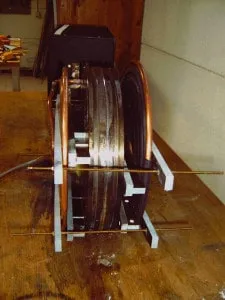Induction Heating Steel Mold For Rubber Seal With High Frequency Heating System
Objective To heat a steel mold evenly to 392ºF (200ºC) to be used on a press for rubber seal vulcanization
Material Steel mold 13.4” (340mm) diameter, 2.16” (55mm) width,
approximately 77.2 lbs (35kg)
Temperature 392ºF (200ºC)
Frequency 20kHz
Equipment • DW-MF-70kW induction heating system, equipped with a remote workhead containing eight 0.3μF capacitors for a total of 0.6μF
• An induction heating coil designed and developed specifically for this application.
Process Two thirteen turn pancake coils are used to heat both sides of the mold simultaneously for 170 seconds to reach an external temperature of 392ºF (200ºC). The power is continually decreased over the next 390 seconds to reach a uniform temperature of 392ºF (200ºC) ± 41ºF (5ºC) throughout the
mold.
Results/Benefits Induction heating provides:
• Repeatable and consistent heat
• Quicker process time, increased production
• Even distribution of heating


